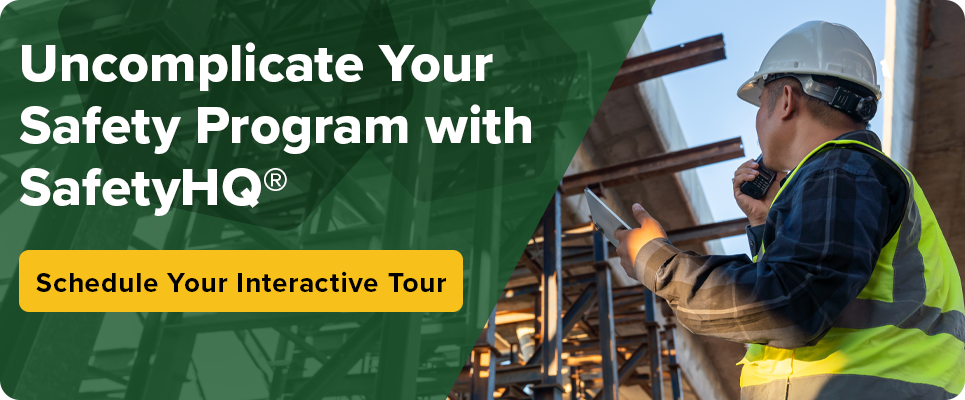
Summer is finally here, and with it comes hot temperatures that can damage your equipment, your jobsites, and most importantly, your crews. Protecting your team as they work in the rising temperature could mean the difference between life or death.
According to OSHA, in the last two decades, heat stress has killed over 285 construction workers in the U.S. and injured far more. However, many heat-related incidents go unreported, so these statistics barely scratch the surface of demonstrating heat’s true toll on the workforce.
But dangerous heat-related incidents can be prevented. With the help of health and safety management software, safety managers can ensure their crew is being protected from the high temperatures and the risks that come with heat.

Key Takeaways for Construction Health and Safety Managers:
- There are precautions a safety manager can take to avoid the dangers associated with overheating by creating a heat safety plan and reminding workers to hydrate, wear sun protection, get acclimated to the heat and monitor heat exhaustion symptoms.
- Construction health and safety management software offers a variety of ways to identify potential hazards, like tracking employee training and certifications and streamlining the process of incident reporting.
- Find a software solution that offers advanced reporting and analytics features, document management, and integration capabilities that best meet your specific needs and help create a safer work environment for your crews.
- Using a construction health and safety management software can allow construction safety managers to prevent heat-related accidents, prepare for incidents that occur in higher temperatures and prepare an emergency response plan to ensure your crew is aware of the risks.
What Should You Know Before Working in Hot Temperatures?
Construction workers are particularly susceptible to heat stress. The physical nature of the work, like lifting heavy objects or operating machinery for extended periods, inevitably produces more internal heat, which increases the risk of exhaustion.
Furthermore, exposure to direct sunlight is also a concern. Depending on the trade, some employees will be working in the open, without cover, for an entire shift. Sun burns, heat stroke and sun poisoning could all come into play.
Then, of course, there is the stereotypical “uniform.” Construction workers are usually decked out in personal protective equipment necessary for the job site, like hard hats, heavy boots, gloves, and protective suits. PPE is always necessary for safety, but this additional weight in cloth and plastic can cause the body to overheat.
During the summer, the sun and the heat could negatively impact a project. However, there are precautions a safety manager can take in order to avoid the dangers associated with overheating.
Remind staff of things like:
Hydration
Staying hydrated is crucial. Workers should drink plenty of water while avoiding sugary drinks or caffeine, even if they don’t feel thirsty. Aim for water breaks at around 15-20 minutes intervals while encouraging workers to take regular breaks in shaded or air-conditioned areas.
Acclimatization
It can be easy to get caught up in the job, so remind new or returning workers not to jump straight into long shifts in extreme heat. All workers should gradually increase their workload and heat exposure over a week or two to allow the body time to adjust to the temperature.
Symptoms
Workers should be aware of the signs of heat stress, or other heat-related illnesses, like dizziness, fatigue, nausea and rapid heartbeat. If they experience these symptoms, they should immediately seek a controlled temperature environment, rest their body in a cool area, and rehydrate. Always encourage workers to communicate their heat stress concerns to supervisors and take frequent breaks when needed.
Sun Protection
Remind workers, especially those working in hot environments, to wear sunscreen and a wide-brimmed hat to protect from sunburn and heatstroke risk. Be sure to encourage workers to wear loose, lightweight, and breathable clothing to help with air circulation and sweat evaporation. This can help ward off heat stress before it becomes too overwhelming.
The Heat Safety Plan
As a construction safety manager, always have a heat safety plan in place that outlines procedures for working in hot weather, including hydration protocols, break schedules and emergency response measures in case of a heat illness. Using health and safety management software specific to construction workers can help you manage your construction safety program by distributing the information to workers and ensuring they’re aware of protocols.
What is Construction Health and Safety Management Software?
In the construction industry, health and safety management software is a digital tool that can help companies streamline their safety programs and keep workers safe. Imagine it as a digital toolbox designed to reduce the amount of accidents and injuries on the jobsite.
Specifically, health and safety management software helps construction companies:
- Create a safer work environment
- Improve regulatory compliance
- Reduce insurance costs
The software also offers a variety of ways to identify potential hazards, like tracking employee training and certifications and streamlining the process of incident reporting.
How Does Construction Safety Software Keep Your Crews Safe in the Heat?
Construction safety management software plays a vital role in keeping crews safe during hot weather by focusing on prevention, preparation, and response.
Accident Prevention
Safety management systems can be used to distribute accident prevention, safety information, and training materials to all crew members to ensure everyone is aware of all risks and preventive measures. You can tailor these to be specific about accidents that commonly occur due to high temperatures and provide detailed information about how workers can protect themselves.
This also provides crew members with documentation of heat safety measures and incident reports that are stored within the software. It can also help promote worker safety and provide historical data about accident prevention that can be helpful during government audits.
Incident Preparation
Safety management systems can manage and track jobsite hazards and risks. Identifying potential workplace-related incidents early on allows you to enact preventative measures early and offer warnings to crew members prior to any issues occurring.
Safety management software offers real-time reporting and analytics so you can address potential hazards like completing strenuous tasks in peak heat hours. This allows you to adjust the schedule so that the crew can work on high-energy tasks during cooler temperatures.
Emergency Response
Construction safety management solutions can store and manage emergency response plans for when accidents like heat stress occur. These documents can be easily stored and accessed for referencing to ensure supervisors and crew members are aware of the procedures to follow in case of a heat-related emergency.
You can also use a safety management software for construction to customize Toolbox Talks and safety meetings. Or, the software will offer pre-built resources including heat stress Toolbox Talks and other relevant documentation. With a cloud-based safety management software or health and safety management mobile app, these guides can be accessed on any device to inform construction workers about safety topics. You can also automate notifications so that workers can be reminded to complete the safety training and track which workers have completed the safety topic.
What Additional Features Should You Look for In Construction Safety Software?
The specific features you need will depend on the size and complexity of your construction projects, as well as your company’s safety culture and priorities. Consider these additional features to find a software solution that best meets your specific needs and helps create a safer work environment for your crews.
Advanced Analytics and Reporting
- Real-time Dashboards: Be proactive and identify potential problems with software that offers real-time dashboards with quick access to key safety metrics like incident rates, near misses, and safety observations.
- Customizable Reports: The ability to generate customized reports on specific projects, crew members, or safety hazards that are tailored to your company’s specific needs is extremely valuable.
- Trend Analysis: Software that can analyze safety data over time to identify trends and patterns is crucial as it helps predict potential issues and allows for targeted interventions.
Improved Communication and Collaboration
- Mobile Application: A mobile app allows workers to access safety information, report incidents, and complete checklists on the go, which improves communication and keeps everyone informed.
- Document Management: The ability to store and share safety documents, policies, and procedures within the software centralizes important information and ensures everyone has access to the latest versions.
- Task Management and Assignment: Assigning safety tasks and inspections to specific individuals and tracking their completion can improve accountability and streamline safety protocols.
Integration Capabilities
- Project Management Software Integration: The ability to integrate with existing project management software can streamline workflows and improve data sharing between different teams.
- Accounting and Payroll Integration: Integration with your accounting software or payroll service that automatically populates employee and job information can be very beneficial for ensuring workers get paid on time, and the labor costs upload automatically into your system.
See How SafetyHQ® Can Help Your Crew Stay Cool in Hot Temperatures
Summer is the busiest time for construction workers, but it can also be the most dangerous time for them. Avoiding any health and safety risks that high temperatures can cause is vital to keeping your crew members safe.

Using a construction health and safety management software can allow construction safety managers to prevent heat-related accidents, prepare for incidents that occur in higher temperatures and prepare an emergency response plan to ensure your crew is aware of the risks.
When looking to improve your construction health and safety management program, consider the features that are most essential for your company. If you’re looking for a software that offers advanced reporting and analytics, improved crew communication, and additional software integration capabilities, take a look at SafetyHQ, our health and safety management app. We offer hundreds of pre-built safety meeting guides, a safety datasheet library of over 2.5 million documents, customized electronic inspection forms, and so much more.
Share Article
Keep on current news in the construction industry. Subscribe to free eNews!



